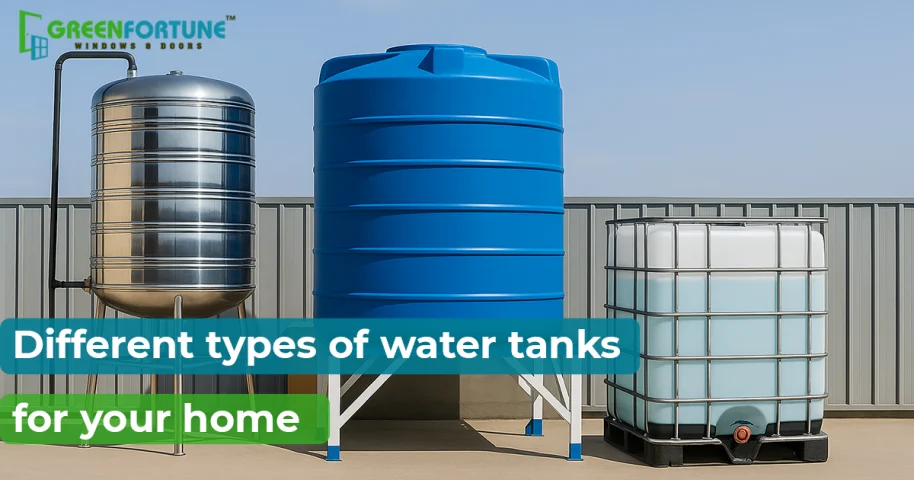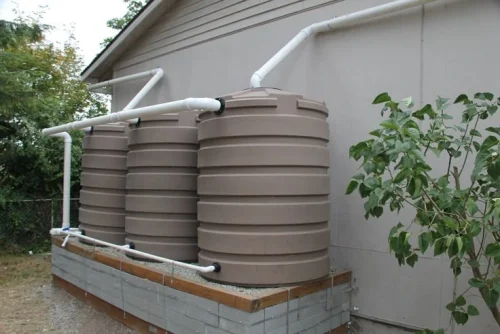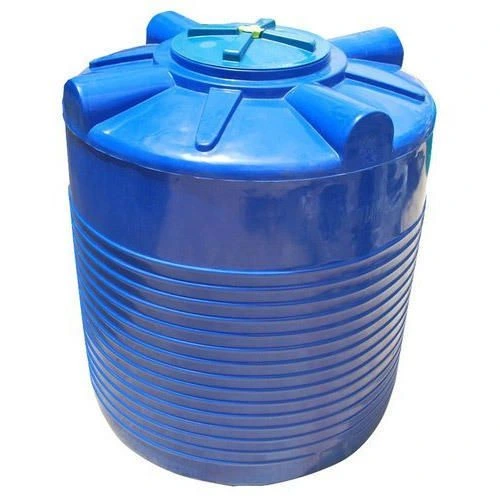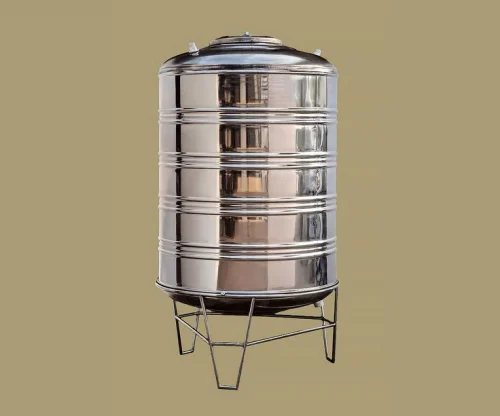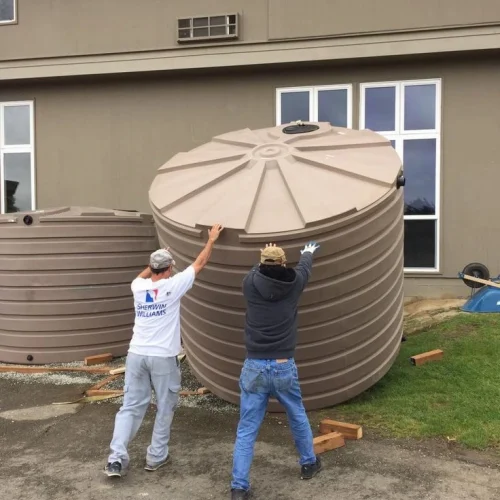
How to Perform a Quality Tiles Test: Ensuring Tiles Meet the Right Standards
April 23, 2025
Best Pipes and Drains for Residential and Commercial Use
April 23, 2025When building a new home or renovating it, some decisions are too important to take lightly. Choosing the right water tank on house is one of them, for sure.
From drinking and cooking to bathing and cleaning, your daily life depends on water. It is like the backbone of your home. That’s why it’s crucial to have proper water storage.
If you are searching for “which water tank is best for home” or trying to understand your options for water storage at home, you are in the right place.
In this blog, let’s explore the different types of water tanks you can install in your house.
Source: Pinterest
Also read: Stages Of House Construction
Types of Water Tanks For Homes
When it comes to choosing a water tank on house, there are various types available. Based on the material they are made from, let’s discuss some of the popular options.
1. Plastic Water Tanks
Source: Pinterest
It’s a common sight to see a plastic water tank on houses in India. They are popular because they are affordable, lightweight, and easy to install. Most of them are made from either polyethylene or HDPE (high-density polyethylene), a stronger, more durable and improved version of the former.
Advantages:
- Plastic tanks are resistant to rust and corrosion. They are very easy to maintain.
- They are available in various sizes, ranging from 500 litres to over 10000 litres. They are suitable for both small homes and bigger ones.
- Nowadays, many plastic tanks come with UV protection to prevent sunlight damage. This prevents the growth of algae.
Disadvantages:
- Plastic tanks are not as strong as other materials. They develop cracks easily over time if exposed to extreme temperatures.
- They are not the best option for underground storage as they cannot handle soil pressure.
- If placed directly under the sunlight, there is a high chance for algae to form inside. They require frequent cleaning.
However, HDPE tanks are suitable for areas with high exposure to sunlight. They have better UV resistance and increased durability.
Tips:
- Plastic tanks are suitable for overhead water storage, such as rooftop tanks, and indoor loft tanks.
- Make sure you choose a UV-protected plastic tank, as it will last longer under the sun.
2. Stainless Steel Water Tanks
Source: Pinterest
Stainless steel water tanks are one of the best and safest options for drinking water storage. It is because unlike plastic tanks, they do not leach chemicals into the water.
Advantages:
- Stainless steel tanks are exceptionally durable and known for their water purity.
- They are highly resistant to rust, corrosion and bacteria growth. They require very little maintenance when compared to other options.
- They can easily withstand high water pressure and are suitable for multi-story buildings and households with a high water demand.
- They are stronger and are less likely to crack or get damaged.
Disadvantages:
- Stainless steel water tanks are expensive than plastic or concrete tanks.
- They are heavy and so a bit difficult to install. They require a solid foundation.
- They conduct heat, and so, the water stored in a stainless steel tank when exposed to direct sunlight for house, can get warm.
- There aren’t many design options.
Tips:
- Stainless steel tanks are suitable if you want to install a water tank on house or ground-level installations. All you need to check is for the strong structural support.
- If the tank is exposed to direct sunlight, consider using an insulated or double-walled stainless steel tank to keep the water cooler.
Also read: Essential Materials Used In Construction
3. Fiberglass Water Tanks
Source: Pinterest
Fiberglass is a non-reactive material made from layers of glass fibers and resin. Tanks made out of fiberglass do not alter the taste or quality of the stored water.
Advantages:
- Fiberglass water tanks are strong, durable and corrosion resistant. They last longer than plastic and steel tanks.
- They are ideal for storing water of all types, including slightly saline or mineral-heavy water.
- They are lightweight, so they are easy to transport and install.
- They are suitable for areas with chemical exposure or harsh climates because they are resistant to extreme weather conditions.
Disadvantages:
- Fiberglass water tanks are more expensive than others and require professional installation to prevent cracks or any structural damage.
- They can become brittle over time if not properly maintained.
- Usually, they are not available readily at the local markets like plastic or concrete tanks.
Tips:
- Check if the fiberglass water tank is food-grade certified before using it for storing water.
- They are suitable for both overhead and underground water storage, especially in coastal areas or regions with very harsh sun exposure.
4. Concrete Water Tanks
Source: Pinterest
Concrete water tanks are one of the strongest and most durable options for water storage. They last for decades with proper maintenance, and so is one of the best options for a water tank on house. They are used for storing large amounts of water, preferably in apartments, farmhouses and for industrial use.
Advantages:
- Concrete water tanks keep the water cool even in hot weather.
- They provide amazing insulation and are perfect for areas where the temperature fluctuates a lot.
- They can be custom-built based on the size and shape you require.
Disadvantages:
- Concrete water tanks are of high cost and require skilled labour for construction.
- Over time, they may develop cracks, which lead to leaks if not properly maintained.
- Cleaning a concrete tank is not an easy thing. It is more challenging.
Tips:
- Concrete water tanks are suitable for large-scale and underground water storage.
- These tanks are porous. So, it is better to make sure they are properly sealed inside to prevent any leakage over time.
Also read: Sand Types And Their Uses In Construction
How To Choose The Best Home Water Storage Option?
Source: Pinterest
When selecting a water tank on house, here are some important factors to consider.
- Capacity
- Installation location
- Durability
- Budget
If yours is a small family, a 500 to 1000-litre water tank may be enough. For large households, 2000 to 5000-litre tanks or more are required.
For overhead storage, plastic and steel tanks are the best options. For underground storage, concrete and fiberglass are perfect.
If you are looking for a durable option, steel, concrete, and fiberglass are the best. They provide long-term value.
If you are on a budget, plastic water tanks are made for you. They are affordable and easier to maintain.
Conclusion
A water tank on house is an essential investment. You must choose the best for safe, clean and reliable water usage. Whether it’s plastic, steel, concrete or fiberglass, pick the one that fits your needs and budget.
If you are looking to buy windows and doors for your home, check out GreenFortune’s uPVC solutions. Our uPVC doors and windows are weather-resistant, highly durable, eco-friendly, soundproof, fire retardant, safe and easy to install and maintain.
FAQs
1). Which colour water tank is best for home?
Black water tanks are best for homes because they block sunlight, stop algae from growing inside and keep water clean for longer. The next best options are blue and green. Make sure to choose UV UV-protected tank.
2). Where should a water tank be placed in a house?
The best place to keep a water tank is the rooftop. It gives good pressure to water without pumps. If it is not possible, ground-level or inside the lofts are also perfect. Make sure you place the tank where it gets shade.
3). How much will the water tank cost?
A 1000-litre plastic tank costs INR 4,600 to INR 17,000. Concrete tanks are often custom built and the price varies based on materials and labour. Stainless steel tanks are costly, around INR 20,000 to INR 50,000. Fiberglass tanks are less common and costlier than plastic, but exact rates vary based on location and brand.







